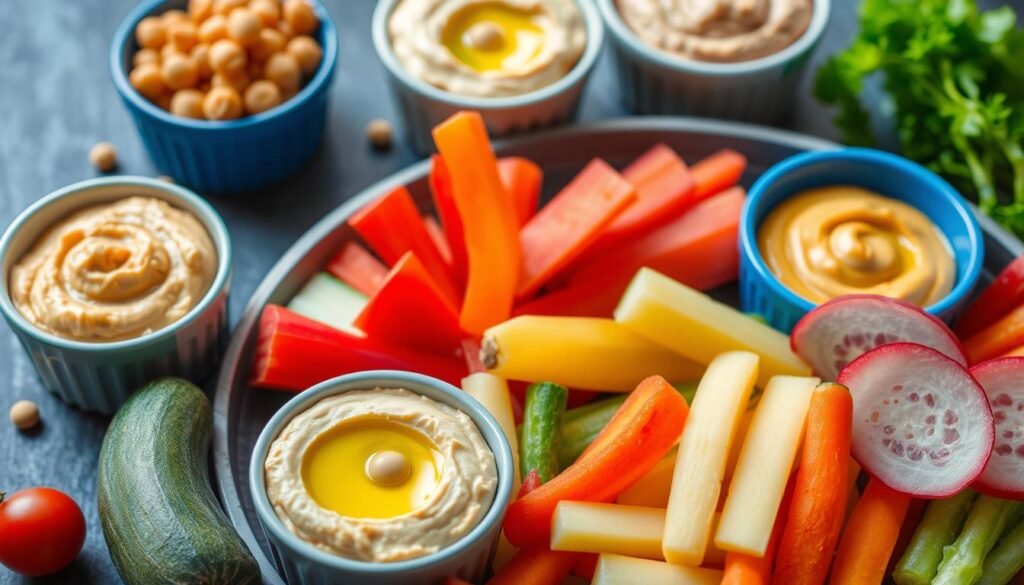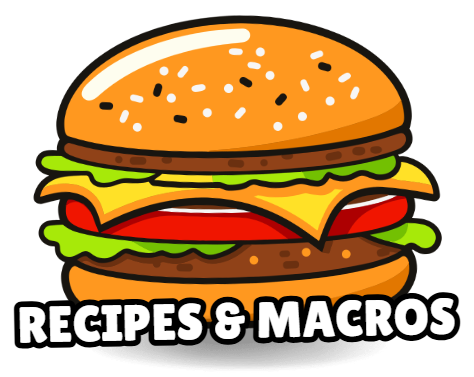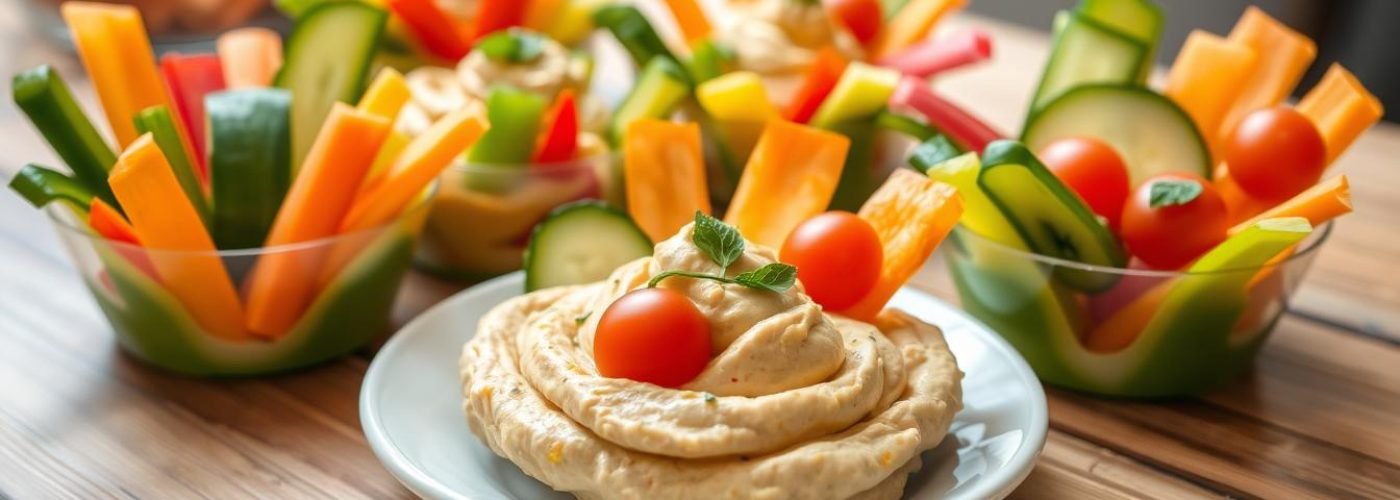If you’re on the lookout for Healthy Snacks that are both nutritious and satisfying, look no further than Protein-Packed Hummus & Veggie Cups. This trend is gaining momentum among health-conscious individuals seeking convenient, tasty options for their busy lifestyles. Hummus, primarily crafted from wholesome chickpeas, serves as a fantastic base for a High Protein Dip. Not only does it provide incredible health benefits, but it also pairs perfectly with a variety of crunchy veggies, making it an ideal choice for snacking.
What Makes Hummus a Healthy Choice?
Hummus stands out as a nourishing food choice, offering a variety of health benefits. Its creamy texture comes from a blend of nutritious ingredients, which enhance its overall appeal. The combination of chickpeas, tahini, and olive oil contributes significantly to its health advantages. Each component plays a role in fostering wellness.
Nutritional Benefits of Hummus
One of the primary aspects of hummus is its Health Benefits of Hummus. It is rich in fiber, which promotes healthy digestion. This fiber content can assist in maintaining stable blood sugar levels thanks to its low glycemic index. Additionally, hummus can provide a feeling of fullness, making it an excellent choice for those aiming to manage their weight.
Ingredients That Pack a Protein Punch
The star of the dish, chickpeas, contribute to the exceptional Nutritional Value of Chickpeas. They are high in protein, making hummus a great option for those looking to incorporate more Protein-Rich Ingredients into their diet. This protein is essential for muscle repair and metabolism, creating a wholesome snack that goes beyond just flavor.
| Ingredient | Nutritional Value (per 100g) | Health Benefits |
|---|---|---|
| Chickpeas | 164 calories, 8.9g protein, 2.6g fat | Supports muscle health and provides essential nutrients |
| Tahini | 595 calories, 17g protein, 53g fat | Rich in healthy fats and calcium |
| Olive Oil | 884 calories, 0g protein, 100g fat | Contains antioxidants and heart-healthy fats |
Ingredients for Protein-Packed Hummus
Creating the perfect protein-packed hummus involves selecting high-quality ingredients that enhance both flavor and nutrition. The choice of chickpeas significantly impacts the final taste and texture. In this section, discover the best chickpeas for hummus, flavor enhancers to elevate your recipe, and how fresh herbs and spices can contribute to a more vibrant blend.
Choosing the Right Chickpeas
For a creamy and satisfying hummus, the choice between canned and dry chickpeas is crucial. Canned chickpeas offer convenience, while dry chickpeas allow for more control over texture and flavor. When opting for dry chickpeas, soak them overnight and cook until tender. The best chickpeas for hummus should ideally be organic, ensuring a natural taste free from additives.
Boosting Flavor with Additives
Enhancing your hummus can be easily achieved with the right additives. Consider incorporating roasted garlic for a rich, aromatic flavor. Fresh lemon juice not only adds brightness but also balances the creaminess of tahini. These flavor enhancers in hummus can turn a simple dip into a culinary delight.
Fresh Herbs and Spices
Adding fresh herbs and spices can elevate your hummus to extraordinary heights. Parsley adds a fresh, earthy note, while cumin provides a warm spice that rounds out the flavors. Experimenting with various combinations of herbs will ensure each batch of hummus is uniquely delicious and packed with health benefits.
Protein-Packed Hummus & Veggie Cups: Recipe Steps
Creating delicious protein-packed hummus and veggie cups is straightforward with clear Hummus Recipe Steps. This guide includes detailed directions for preparing the hummus and assembling your veggie cups for that perfect Protein Snack Recipe.
Step-by-Step Directions for Hummus Preparation
To whip up a tasty and creamy hummus, gather the following ingredients:
- 1 can (15 oz) chickpeas, drained and rinsed
- 1/4 cup tahini
- 2 tablespoons olive oil
- 2 garlic cloves, minced
- 2 tablespoons freshly squeezed lemon juice
- 1/2 teaspoon salt
- Water as needed for desired consistency
Begin by adding the chickpeas, tahini, olive oil, garlic, lemon juice, and salt to a blender or food processor. Blend until smooth, adding water bit by bit until you reach your preferred texture. Scrape down the sides intermittently to ensure an even mix.
How to Assemble Veggie Cups
Once the hummus is ready, it’s time for the Veggie Cups Assembly. Choose a vibrant variety of vegetables to accompany your hummus. Some great options include:
- Carrot sticks
- Cucumber slices
- Bell pepper strips
- Cherry tomatoes
- Celery sticks
Fill small cups or jars with hummus, then layer the veggies upright in the cups. This not only looks appealing but makes for a convenient snack that is perfect for gatherings or meal prep!

Customizing Your Hummus Recipe
Hummus is a remarkably versatile dish that allows anyone to explore various flavors and textures. Custom Hummus Flavors can elevate your snacking experience and impress guests at gatherings. With a few tweaks, individuals can create remarkable, personalized options that suit their tastes and dietary needs.
Flavor Variations to Try
Experimenting with different Variations on Hummus opens new culinary doors. Here are some enticing options to consider:
- Roasted Red Pepper: Add roasted red peppers for a smoky, slightly sweet flavor.
- Avocado: Blend in ripe avocado for a creamy texture and a boost of healthy fats.
- Spicy Harissa: Incorporate harissa paste for a kick of heat and complexity.
- Herbed Cilantro Lime: Fresh cilantro and lime juice create a refreshing twist.
Using Different Beans for Protein Boost
Choosing different beans allows for exciting Protein Bean Options while adding unique flavors. For instance, swapping chickpeas with black beans can introduce a rich taste profile. Kidney beans also provide a hearty texture and a slight sweetness. Here’s how these alternatives can compare:
| Bean Type | Flavor Profile | Protein Content (per 100g) |
|---|---|---|
| Chickpeas | Nutty, creamy | 8.9g |
| Black Beans | Earthy, rich | 8.9g |
| Kidney Beans | Sweet, hearty | 8.7g |
These flavorful options not only cater to varied palates but also accommodate dietary preferences, such as vegan and gluten-free needs. By customizing your hummus recipe, you can offer delicious, healthful snacks that appeal to everyone!
Healthier Veggie Options for Your Cups
When creating Colorful Veggie Cups for dipping into hummus, selecting the right vegetables can enhance both nutritional value and presentation. Incorporating a variety of colors not only makes the snack visually appealing but also increases the health benefits. Here are some ideal Healthy Vegetables for Snacks that you can include.
Best Vegetables for Snacking
- Carrots: Crunchy and naturally sweet, carrots are rich in beta-carotene and vitamin K.
- Bell Peppers: Available in various colors, these are high in vitamins A and C, adding vibrant colors to your cups.
- Cucumber: With a refreshing taste and hydrating properties, cucumbers are low in calories and provide a satisfying crunch.
- Cherry Tomatoes: Juicy and delicious, cherry tomatoes are full of antioxidants and provide a sweet burst when biting into them.
Colorful Combinations for Appeal
Combining different colors of vegetables not only makes for visually stunning Colorful Veggie Cups but also maximizes health benefits. Here are some suggested combinations:
| Vegetable Combination | Benefits |
|---|---|
| Carrots & Hummus | High in beta-carotene; supports eye health. |
| Bell Peppers & Hummus | Rich in vitamins A and C; boosts immune function. |
| Cucumber & Cherry Tomatoes | Great for hydration; antioxidants promote heart health. |
| Mixed Veggies with Spices | Variety increases nutrient intake and adds flavor. |
Macros of Protein-Packed Hummus & Veggie Cups
Understanding the Hummus Macronutrient Breakdown is essential for those looking to enjoy their snacks while keeping an eye on their nutrition. Protein-packed hummus and veggie cups provide a balance of macronutrients that make them a satisfying choice for any meal or snack time. In this section, the focus lies on the caloric content and macronutrient ratios, ensuring clarity in dietary approaches.
Caloric Breakdown of Each Serving
The caloric content of veggie cups can vary based on the ingredients used. Generally, a serving of hummus with accompanying vegetables provides a low-calorie option without sacrificing flavor or nutrition. Here’s a quick overview:
| Item | Calories | Protein (g) | Fat (g) | Carbohydrates (g) |
|---|---|---|---|---|
| Hummus (2 tbsp) | 70 | 2 | 4 | 6 |
| Mixed Veggies (1 cup) | 25 | 1 | 0 | 5 |
| Total per Serving | 95 | 3 | 4 | 11 |
Understanding Macronutrient Ratios
For those looking to prepare high protein snacks, analyzing macronutrient ratios becomes crucial. Protein-packed hummus is primarily a source of plant-based protein, supplemented by fiber from the veggies. Typically, the ratio leans towards lower fat and carbohydrates, making it a smart option for health-conscious individuals. The suggested ratio for these snacks could be visualized as follows:
- Protein: 25%
- Fat: 30%
- Carbohydrates: 45%
This balanced approach makes the combination a perfect fit for anyone aiming to enjoy healthier snacking without the guilt. The appeal of these snacks lies not just in their nutritional profile, but in their versatility and delectable flavor.

Meal Prep Ideas with Hummus and Veggie Cups
Preparing your meals for the week can save time and ensure you have nutritious, convenient options on hand. Meal Prep Hummus is a fantastic base for delicious Make-Ahead Snacks, perfect for busy lifestyles. By following some simple tips, you can create a variety of snacks to enjoy throughout the week.
Batch Cooking Tips
Making a large batch of hummus at once allows you to quickly grab portions for your meal. When preparing Meal Prep Hummus, consider these helpful tips:
- Use high-quality chickpeas, either canned or dried.
- Experiment with flavors, such as garlic, roasted red peppers, or lemon juice.
- Portion the hummus into individual servings using small containers for easy access.
Storing Your Hummus for Freshness
To maintain the flavor and texture of your hummus, utilize these effective Hummus Storage Tips:
- Store hummus in airtight containers to prevent air exposure.
- Keep portions in the refrigerator for up to one week.
- For longer storage, freeze hummus in ice cube trays, transferring it to a container once frozen.
Serving Suggestions and Pairings
When it comes to serving hummus, consider incorporating complementary dips to elevate the experience. Whether it’s a casual gathering or a special event, knowing the right snack pairing ideas can make your presentation even more appealing.
Best Dips to Complement Your Cups
Enhance your protein-packed hummus with a variety of dips that offer unique flavors and textures. Here are some popular options:
- Tzatziki: This yogurt-based dip adds a refreshing taste that pairs perfectly with the creaminess of hummus.
- Guacamole: The richness of avocados perfectly balances the flavors of hummus, creating a delicious combination.
- Pesto: A basil pesto brings a burst of herbal freshness that complements the chickpeas beautifully.
- Roasted Red Pepper Dip: This dip brings a smoky sweetness that enhances the overall flavor profile.
Perfect Occasions for Serving
Protein-packed hummus and veggie cups are ideal for a variety of occasions where guests appreciate nutritious snack options:
- Parties: Offer your guests a healthy alternative during social gatherings.
- Picnics: These cups are easy to transport and allow guests to snack while enjoying the outdoors.
- Health-Focused Events: Perfect for gatherings centered on wellness, where guests can indulge without guilt.
Experiment with various dips and occasions to make your serving experience unique and enjoyable.
Why Choose Homemade Over Store-Bought?
When it comes to hummus, the benefits of homemade hummus far outweigh those of their store-bought counterparts. One of the primary advantages is the freshness of ingredients. Homemade hummus allows you to control every component, ensuring you’re using high-quality chickpeas, olive oil, and spices without any unnecessary preservatives or additives that are often found in pre-packaged versions.
Another key factor is the customization opportunities that homemade hummus provides. You can experiment with flavors, adjusting garlic levels, adding fresh herbs or even incorporating different beans for added protein. This versatility makes it easy to cater to personal tastes, creating truly unique and delicious dips that store-bought hummus simply cannot match when discussing healthier snack options.
Ultimately, choosing to make hummus at home not only enhances your culinary experience but also fosters a better understanding of what you are consuming. In a world where health-conscious consumers are increasingly wary of ingredients, knowing exactly what goes into your food offers peace of mind. This thoughtful approach leads to a clear advantage in the ongoing debate of store-bought vs homemade, making your dips tastier and healthier in every way.

